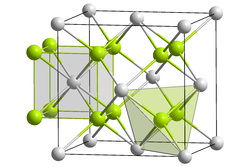
Back اوکسید نپتونیوم (IV) AZB Oxid neptuničitý Czech Neptunium(IV)-oxid German اکسید نپتونیوم (IV) Persian Oxyde de neptunium(IV) French Neptunium(IV) oksida ID Оксид нептуния(IV) Russian Neptunijum(IV) oksid Serbo-Croatian Neptunijum(IV) oksid Serbian நெப்டியூனியம்(IV) ஆக்சைடு Tamil

| |

| |
| Names | |
|---|---|
| IUPAC name
Neptunium(IV) oxide
| |
| Other names
Neptunium oxide, neptunium dioxide
| |
| Identifiers | |
3D model (JSmol)
|
|
| ChemSpider | |
| ECHA InfoCard | 100.031.651 |
| EC Number |
|
PubChem CID
|
|
| |
| |
| Properties | |
| NpO2 | |
| Molar mass | 269 g/mol |
| Appearance | Green cubic crystals |
| Density | 11.1 g/cm3 |
| Melting point | 2,800 °C; 5,070 °F; 3,070 K[1] |
| Structure[2] | |
| Flourite (cubic), cF12 | |
| Fm3m, #225 | |
a = 543.4 pm
| |
Formula units (Z)
|
4 |
| Thermochemistry | |
Std molar
entropy (S⦵298) |
19.19 ± 0.1 cal·mol−1·K−1 (80.3 ± 0.4 J·mol−1·K−1)[3] |
Std enthalpy of
formation (ΔfH⦵298) |
−256.7 ± 0.6 kcal·mol−1 (−1074 ± 3 kJ·mol−1)[4] |
| Related compounds | |
Other anions
|
Neptunium(III) chloride Neptunium(IV) chloride |
Other cations
|
Protactinium(IV) oxide Uranium(IV) oxide Plutonium(IV) oxide Americium(IV) oxide |
Except where otherwise noted, data are given for materials in their standard state (at 25 °C [77 °F], 100 kPa).
| |
Neptunium(IV) oxide, or neptunium dioxide, is a radioactive, olive green[5] cubic[6] crystalline solid with the formula NpO2. It emits both α- and γ-particles.[4]
- ^ Böhler, R.; M. J. Welland; F. De Bruycker; K. Boboridis; A. Janssen; R. Eloirdi; R. J. M. Konings; D. Manara (2012). "Revisiting the melting temperature of NpO2 and the challenges associated with high temperature actinide compound measurements". Journal of Applied Physics. 111 (11). American Institute of Physics: 113501–113501–8. Bibcode:2012JAP...111k3501B. doi:10.1063/1.4721655.
- ^ Christine Guéneau; Alain Chartier; Paul Fossati; Laurent Van Brutzel; Philippe Martin (2020). "Thermodynamic and Thermophysical Properties of the Actinide Oxides". Comprehensive Nuclear Materials 2nd Ed. 7: 111–154. doi:10.1016/B978-0-12-803581-8.11786-2. ISBN 9780081028667. S2CID 261051636.
- ^ Westrum, Jr., Edgar F.; J. B. Hatcher; Darrell W. Osborne (March 1953). "The Entropy and Low Temperature Heat Capacity of Neptunium Dioxide". Journal of Chemical Physics. 21 (3): 419. Bibcode:1953JChPh..21..419W. doi:10.1063/1.1698923.
- ^ a b Huber Jr, Elmer J.; Charles E. Holley Jr (October 1968). "Enthalpy of formation of neptunium dioxide". Journal of Chemical & Engineering Data. 13 (4): 545–546. doi:10.1021/je60039a029.
- ^ Patnaik, Pradyot (2003). Handbook of Inorganic Chemical Compounds. McGraw-Hill Professional. p. 271. ISBN 0-07-049439-8.
- ^ Lide, D. R. (1998). Handbook of Chemistry and Physics 87 ed. CRC Press. p. 471. ISBN 0-8493-0594-2.
© MMXXIII Rich X Search. We shall prevail. All rights reserved. Rich X Search